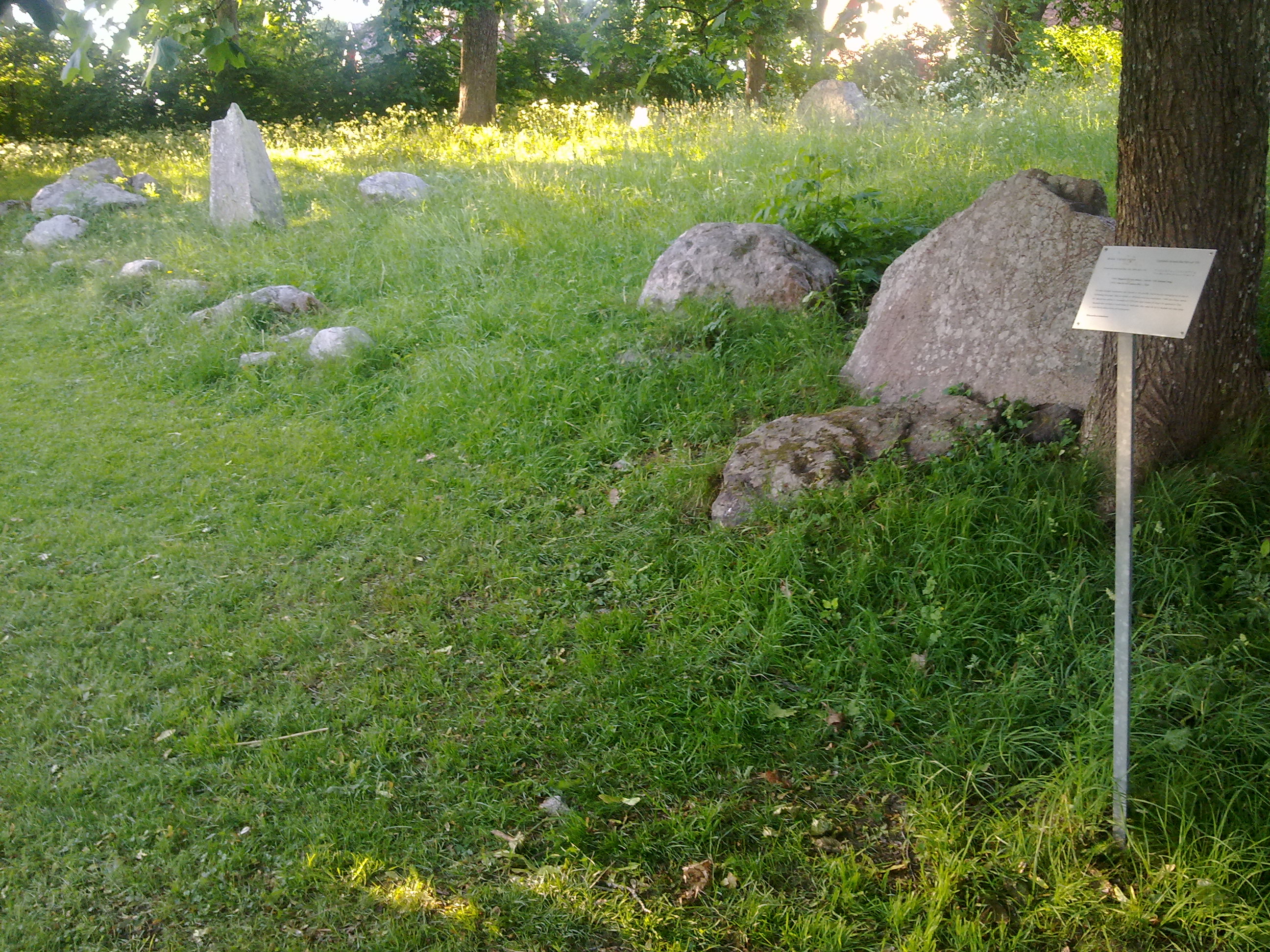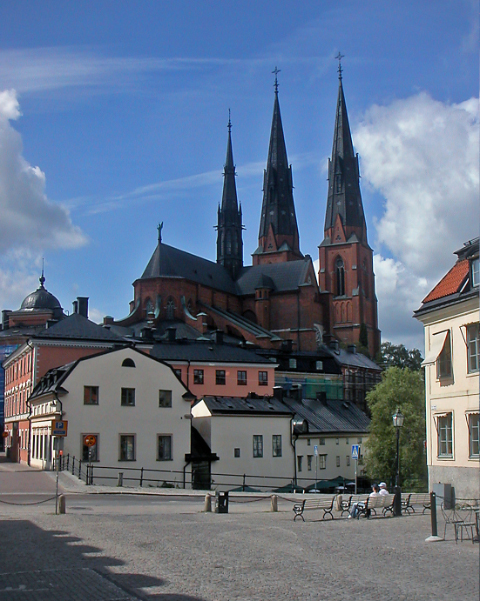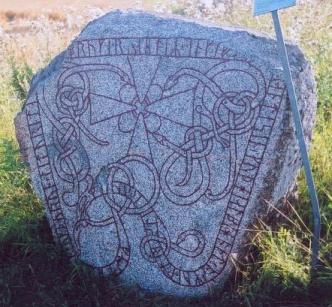|
Uppland Runic Inscription 1144
Uppland Runic Inscription 1144 or U 1144 is the Rundata catalog designation of a Viking Age memorial runestone in a churchyard that is located five kilometers southwest of Tierp, Uppsala County, Sweden, which was in the historic province of Uppland. Description The runic inscription consists of runic text within bands that are around an unusual image of a Christian cross surrounded by stylized serpents and two lambs. It has been suggested that the runestone's iconography of an adoring lamb on each side of the cross may have been based on similar images seen during pilgrimages to Rome or the Holy Land. The stone is composed of granite and is 1.8 meters in height with the upper right portion missing. The inscription is classified as being carved in runestone style Pr3, which is also known as Urnes style. This runestone style is characterized by slim and stylized animals that are interwoven into tight patterns. The animal heads are typically seen in profile with slender almond-sh ... [...More Info...] [...Related Items...] OR: [Wikipedia] [Google] [Baidu] |
U 1144, Tierp
U or u, is the twenty-first and sixth-to-last letter and fifth vowel letter of the Latin alphabet, used in the modern English alphabet, the alphabets of other western European languages and others worldwide. Its name in English is ''u'' (pronounced ), plural ''ues''. History U derives from the Semitic waw, as does F, and later, Y, W, and V. Its oldest ancestor goes to Egyptian hieroglyphics, and is probably from a hieroglyph of a mace or fowl, representing the sound Voiced_labiodental_fricative.html" ;"title="nowiki/> vor the sound [Voiced labial–velar approximant">w">Voiced labiodental fricative">vor the sound [Voiced labial–velar approximant">w This was borrowed to Phoenician, where it represented the sound [w], and seldom the vowel [Close back rounded vowel, u]. In Greek language, Greek, two letters were adapted from the Phoenician waw. The letter was adapted, but split in two, with the Digamma, first one of the same name (Ϝ) being adapted to represent w">now ... [...More Info...] [...Related Items...] OR: [Wikipedia] [Google] [Baidu] |
Urnes Style
Viking art, also known commonly as Norse art, is a term widely accepted for the art of Scandinavian Norsemen and Viking settlements further afield—particularly in the British Isles and Iceland—during the Viking Age of the 8th-11th centuries. Viking art has many design elements in common with Celtic, Germanic, the later Romanesque and Eastern European art, sharing many influences with each of these traditions. Generally speaking, the current knowledge of Viking art relies heavily upon more durable objects of metal and stone; wood, bone, ivory and textiles are more rarely preserved. The artistic record, therefore, as it has survived to the present day, remains significantly incomplete. Ongoing archaeological excavation and opportunistic finds, of course, may improve this situation in the future, as indeed they have in the recent past. Viking art is usually divided into a sequence of roughly chronological styles, although outside Scandinavia itself local influences are ofte ... [...More Info...] [...Related Items...] OR: [Wikipedia] [Google] [Baidu] |
Runic Transliteration And Transcription
Runic transliteration and transcription are part of analysing a runic inscription which involves transliteration of the runes into Latin letters, transcription into a normalized spelling in the language of the inscription, and translation of the inscription into a modern language. There is a long-standing practice of formatting transliterations in boldface and transcriptions in ''Italic type'', as the two forms of rendering a runic text have to be kept distinct. Overview By not only showing the original inscription, but also transliterating, transcribing and translating, scholars present the analysis in a way that allows the reader to follow their interpretation of the runes. Every step has its challenges, but most Younger Futhark inscriptions are quite easy to interpret. Most Scandinavians can learn to read runic inscriptions with a little training. The Elder Futhark inscriptions, however, are much more challenging and they demand a great deal of knowledge in historical linguistics. ... [...More Info...] [...Related Items...] OR: [Wikipedia] [Google] [Baidu] |
Uppland Runic Inscription Fv1986 84
Runic inscription U Fv1986;84 is the Rundata catalog number for a Viking Age memorial that is located at Bo gård on the island of Lidingö in Uppland, Sweden. Description This runestone was discovered in 1984 and is carved on a boulder located on the island of Lidingö. The inscription, which is about 2 meters high by 1.4 meters wide, consists of runic text carved on an intertwined serpent. There is a Christian cross near the top of the design. The inscription is classified as being carved in runestone style Pr3 - Pr4, which is also known as the Urnes style. This runestone style is characterized by slim and stylized animals that are interwoven into tight patterns. The animal heads are typically seen in profile with slender almond-shaped eyes and upwardly curled appendages on the noses and the necks. The runic text begins at the bottom of the inscription and reads clockwise along the serpent. The text states that the runemaster Åsmund carved the runes in memory of his grandfat ... [...More Info...] [...Related Items...] OR: [Wikipedia] [Google] [Baidu] |
Bolsta Runestones
The Bolsta Runestones are two Viking Age memorial runestones and two fragments of a third that are located in Bolsta, which is on the east edge of Uppsala, Uppsala County, Sweden, and in the historic province of Uppland. One runestone is signed by the runemaster with the normalized name of Åsmund Kåresson and the other by the runemaster named Öpir. U 968 Upplands Runic Inscription 968 or U 968 is the Rundata catalog listing for two fragments of a runestone that are 0.6 and 0.8 meters in height. The inscription consists of runic text carved in the younger futhark on a serpent. The inscription was recorded during the initial Swedish runestone surveys of the 1600s, but the stone later disappeared. Before the historic nature of runestones was understood, they were often reused as materials in the construction of churches, buildings, and walls. Two fragments of the stone were found in the basement of a village house in the 1880s, and are now located on private property. The insc ... [...More Info...] [...Related Items...] OR: [Wikipedia] [Google] [Baidu] |
Uppsala Cathedral
Uppsala Cathedral ( sv, Uppsala domkyrka) is a cathedral located between the University Hall of Uppsala University and the Fyris river in the centre of Uppsala, Sweden. A church of the Church of Sweden, the national church, in the Lutheran tradition, Uppsala Cathedral is the seat of the Archbishop of Uppsala, the primate of Sweden. It is also the burial site of King Eric IX (c. 1120–1160, reigned 1156–1160), who became the patron saint of the nation, and it was the traditional location for the coronation of new Kings of Sweden. The current archbishop is Martin Modéus and the current bishop is Karin Johannesson. The cathedral dates to the late 13th century and, at a height of , it is the tallest church in the Nordic countries. Originally built under Roman Catholicism, it was used for coronations of Swedish monarchs for a lengthy period following the Protestant Reformation. Several of its chapels were converted to house the tombs of Swedish monarchs, including Gustav Vas ... [...More Info...] [...Related Items...] OR: [Wikipedia] [Google] [Baidu] |
Uppland Runic Inscription 871
U 871 is a 12th-century runestone in the Rundata catalog, originally from Ölsta, a village in the county of Uppland in Sweden. It is now on display at Skansen, near Stockholm. Description It is believed that this stone remained in its original place until 1896. The spot was close to the Eriksgata, the road that the Swedish king travelled after having been elected at the Stone of Mora, in order to be accepted by his subjects. The stone was sold for 50 Swedish kronor in 1896 to the founder of Skansen, Artur Hazelius, where it was moved. It remains at Skansen to this day. The inscription is classified as being carved in runestone style Pr4, which is also known as the Urnes style. This runestone style is characterized by slim and stylized lindworms that are interwoven into tight patterns. The animal heads are typically seen in profile with slender, almond-shaped eyes and upwardly curled appendages on the noses and the necks. The inscription is signed by the runemaster Åsmund Kåre ... [...More Info...] [...Related Items...] OR: [Wikipedia] [Google] [Baidu] |
Uppland Runic Inscription 824
Uppland Runic Inscription 824 is the Rundata catalog number for a Viking Age memorial runestone located at Holms, which is about eight kilometers east of Örsundsbro, Uppsala County, Sweden, and in the historic province of Uppland. The inscription features a facial mask and a bind rune in the text. Description This inscription consists of runic text carved on a serpent that is intertwined with and encircles other serpents. The inscription is classified as being carved in either runestone style Pr3 or Pr4, both of which are considered to be Urnes style. This runestone style is characterized by slim and stylized animals that are interwoven into tight patterns. The animal heads are typically seen in profile with slender almond-shaped eyes and upwardly curled appendages on the noses and the necks. At the top of the inscription but within the outer serpent is a mask of a man's face. This is a common motif and is found on several other runestones including DR 62 in Sjelle, DR 66 in ... [...More Info...] [...Related Items...] OR: [Wikipedia] [Google] [Baidu] |
Baltic Area Runestones
The Baltic area runestones are Varangian runestones in memory of men who took part in peaceful or warlike expeditions across the Baltic Sea, where Finland and the Baltic states are presently located. Beside the runestones treated in this article and in the main article Varangian runestones, there are many other runestones that talk of eastward voyages such as the Greece runestones, Italy runestones, and inscriptions left by the Varangian Guard. Other runestones that deal with Varangian expeditions include the Ingvar runestones (erected in honor or memory of those who travelled to the Caspian Sea with Ingvar the Far-Travelled). In addition, there were also voyages to Western Europe mentioned on runestones that are treated in the articles Viking runestones, England runestones and Hakon Jarl runestones. Below follows a presentation of the runestones based on the Rundata project. The transcriptions into Old Norse are mostly in the Swedish and Danish dialect to facilitate comp ... [...More Info...] [...Related Items...] OR: [Wikipedia] [Google] [Baidu] |
Åsmund Kåresson
Åsmund Kåresson was a Viking Age runemaster who flourished during the first half of the 11th century in Uppland and Gästrikland, Sweden. The early Urnes style is represented in his art. pp. 197, 208–09. Work Most early medieval Scandinavians were probably literate in runes, and most people probably carved messages on pieces of bone and wood.Vilka kunde rista runor?' on the Swedish National Heritage Board website, retrieved January 13, 2007. However, it was difficult to make runestones, and in order to master it one also needed to be a stonemason. During the 11th century, when most runestones were raised, there were a few professional runemasters. Åsmund was active mainly in Uppland, and about twenty runestones are signed by him and an additional thirty stones have been attributed to him. The ornamentation is characterized by variation with firmness and security in the composition. Åsmund is the inventor of the classic Uppland runestone style with one or two animals (''rundjur ... [...More Info...] [...Related Items...] OR: [Wikipedia] [Google] [Baidu] |
Old Norse Orthography
The orthography of the Old Norse language was diverse, being written in both Runic and Latin alphabets, with many spelling conventions, variant letterforms, and unique letters and signs. In modern times, scholars established a standardized spelling for the language. When Old Norse names are used in texts in other languages, modifications to this spelling are often made. In particular, the names of Old Norse mythological figures often have several different spellings. The appearance of Old Norse in a written runic form first dates back to approximately AD 200–300. While there are remains of Viking runestones from the Viking Age today they are rare, and vary in use of orthography depending on when they were created. Rune stones created near the end of the Viking Age tend to have a greater influence from Old English runes. An understanding of the writing system of Old Norse is crucial for fully understanding the Old Norse language. Studies of remaining rune stones from the ... [...More Info...] [...Related Items...] OR: [Wikipedia] [Google] [Baidu] |






